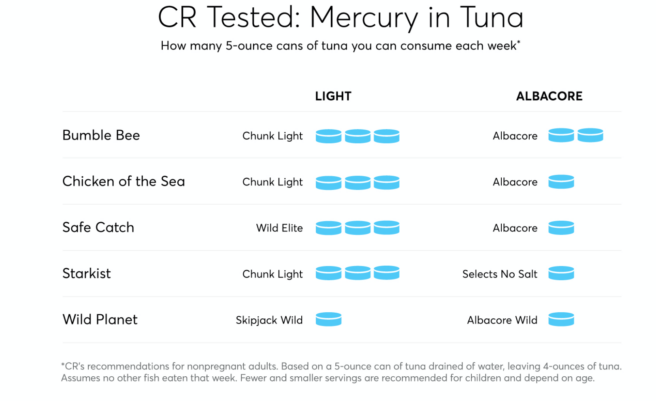Pregnant women shouldn’t eat canned tuna and children and adults should eat less that the FDA recommends according to new research by Consumer Reports.
The organization tested five brands of tuna to check mercury levels. Consumer Reports (CR) tested Bumble Bee, Chicken of the Sea, Starkist, Safe Catch and Wild Planet in cans. Pouch containers have the same kind of tuna as cans, but pouches were not tested.
There was a wide range of mercury levels between types — light and albacore — and brands. Albacore had higher levels of mercury in all brands, not surprisingly because the fish are larger, according to CR.
The researchers found that regardless of brand or type, mercury levels can spike from can to can, therefore making it inadvisable for pregnant women to eat the fish. Mercury is a known neurotoxin and can cause many problems with a developing fetus.
“From can to can mercury levels can spike in unpredictable ways that might jeopardize the health of a fetus,” said James E. Rogers, director of Food Safety Research and Testing for CR. Consequently the consumer protection organization recommends that pregnant women completely avoid canned tuna.
Food and Drug Administration guidelines for vulnerable groups say up to 12 ounces a week of light tuna or four ounces of albacore is acceptable.
Mercury is a health risk for children whose bodies and brains are still growing and harmful to adults, causing problems with fine motor coordination, speech, sleep, walking and prickly sensations.
Canned tuna is widely consumed in America and is often the only fish a person ever eats, according to CR. The well known benefits of fish, including tuna, make it a delicate balancing act to know how much is enough.
About one-third of Americans eat canned tuna two or more times per month and 10 percent eat it at least once a week, according to a Consumer Reports 2022 national survey of 2,185 adults.

The testing process
For its research, Consumer Reports tested three samples of each type of tuna from five brands. All of the tuna was packed in water and was drained before testing.
On average, the albacore tuna had three times more mercury than the light tuna, though there was a wide range in brands. Chicken of the Sea albacore, for example, had10 times the mercury than it’s light tuna did. Wild Planet’s were very close together, and either should be eaten only once per week, according to the researchers.
None of the albacore tested had mercury levels low enough for an adult to have three servings per week, based on CR’s research. Children should not have any albacore at all.
Assuming no other fish is consumed, all but one on the light tunas had levels low enough for adults to eat three 4-ounce servings per week and children two — a person’s weight is a factor, according to the researchers.
Of the 30 samples tested, researchers found six individual spikes that would change the FDA’s recommendations about how often a person should eat that particular type of tuna.
“You may know that in general light tuna has less mercury than albacore, but you can’t tell by just looking how much mercury a specific can has,” Michael Hansen, senior scientist at CR, said.
In three samples from the albacore category mercury was high enough that it shouldn’t be eaten at all — two of Chicken of the Sea and one of Star Kist.
What industry says
Consumer Reports asked all companies and the National Fisheries Institute, a trade association representing canned tuna manufacturers, to comment on the research. The institute said the levels CR found were well below the FDA limit and said the products are safe.
Starkist and Chicken of the Sea said they monitor and their tuna and it meets FDA standards. Bumble Bee said the health benefits of their tuna outweigh potential risk.
Wild Planet said the company has to “make a choice between offering tuna with the very lowest possible mercury level or offering tuna from the best sustainable practice” and that they still have tunas with low levels.
Safe Catch cans say “lowest mercury of any brand” and it does have relatively low levels on light, but most other light tuna was also low and differences were very small compared with Safe Catch, according to Consumer Reports. Similarily, the mercury levels in Safe Catch’s albacore tuna was close to most of the albacore samples from other brands tested and one brand, Bumble Bee, actually had lower levels.
Safe Catch’s Wild Albacore tuna costs up to about $5 per can and its Wild Elite light tuna up to about $3.50 compared to less than $2 for light tuna and less than $3 for albacore from Bumble Bee, Chicken of the Sea and Star Kist. Wild Planet’s skipjack (light) and albacore cost up to $3.50 and $5.60, respectively.
Consumer Reports advice on tuna for children
If your child will only eat tuna and no other fish, safe amounts per week are:
Age 1-3 — 2 ounces
Age 4-7 — 4 ounces
Age 8-10 — 6 ounces
Age 11— 8 ounces
(To sign up for a free subscription to Food Safety News,click here)

